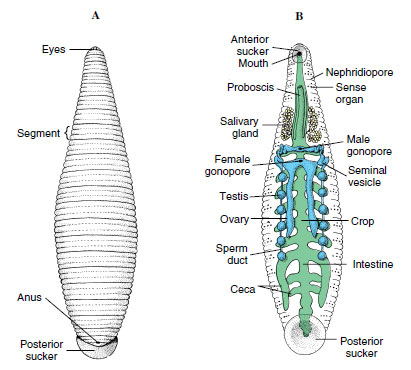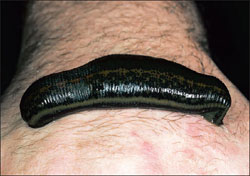Class Hirudinea: Leeches
Class Hirudinea:
Leeches
Leeches occur predominantly in freshwater habitats, but a few are marine, and some have even adapted to terrestrial life in warm, moist places. They are more abundant in tropical countries than in temperate zones. Some leeches attack human beings and are a nuisance.
Most leeches are between 2 and 6 cm in length, but some are smaller; some, including “medicinal” leeches, reach 20 cm, but the giant of all is the Amazonian Haementeria (Gr. haimateros, bloody) (Figure 17-20), which reaches 30 cm.
Leeches occur in a variety of patterns and colors: black, brown, red or olive green. They are usually flattened dorsoventrally. Some are adapted for forcing their pharynx or proboscis into soft tissues such as the gills of fish. The most specialized leeches, however, have sawlike chitinous jaws with which they can cut through tough skin. Many leeches live as carnivores on small invertebrates; some are temporary parasites; and some are permanent parasites, never leaving their host.
Like oligochaetes, leeches are hermaphroditic and have a clitellum, which appears only during breeding season. The clitellum secretes a cocoon for reception of eggs. Leeches are more highly specialized than oligochaetes. As fluid feeders and bloodsuckers, they have lost the setae used by oligochaetes in locomotion and have developed suckers for attachment while sucking blood; their gut is specialized for storage of large quantities of blood.
Form and Function
Unlike other annelids, leeches have a fixed number of somites (usually 34; 15 or 30 in some groups), but they appear to have many more because each somite is marked by transverse grooves to form from two to 16 superficial rings (annuli) (Figure 17-21).
The coelom represents another difference between leeches and other annelids; leeches lack distinct coelomic compartments. In all but one species the septa have disappeared, and the coelomic cavity is filled with connective tissue and a system of spaces called lacunae. The coelomic lacunae form a regular system of channels filled with coelomic fluid, which in some leeches serves as an auxiliary circulatory system.
Most leeches creep with looping movements of the body, by attaching first one sucker and then the other and pulling the body along the surface. Aquatic leeches swim with a graceful undulatory movement.
Nutrition
Leeches are popularly considered parasitic, but many are predaceous. Even the true bloodsuckers rarely remain on the host for a long period of time. Most freshwater leeches are active predators or scavengers equipped with a proboscis that can be extended to ingest small invertebrates or to take blood from cold-blooded vertebrates. Some freshwater leeches are true bloodsuckers, preying on cattle, horses, humans, and others. Some terrestrial leeches feed on insect larvae, earthfrom cold-blooded vertebrates. Some freshwater leeches are true bloodsuckers, preying on cattle, horses, humans, and others. Some terrestrial leeches feed on insect larvae, earthworms, and slugs, which they hold by an oral sucker while using a strong sucking pharynx to ingest food. Other terrestrial forms climb bushes or trees to reach warm-blooded vertebrates such as birds or mammals.
Most leeches are fluid feeders. Many prefer to feed on tissue fluids and blood pumped from wounds already open. True bloodsuckers, which include the so-called medicinal leech Hirudo medicinalis (L. hirudo, a leech) (Figure 17-22), have cutting plates, or “jaws,” for cutting tissues. Some parasitic leeches leave their hosts only during breeding season, and certain fish parasites are permanently parasitic, depositing their cocoons on their host fish.
Respiration and Excretion
Gas exchange occurs only through the skin except in some fish leeches, which have gills. There are 10 to 17 pairs of nephridia, in addition to coelomocytes and certain other specialized cells that also may be involved in excretory functions.
Nervous and Sensory Systems
Leeches have two “brains”; one is anterior and is composed of six pairs of fused ganglia forming a ring around the pharynx, and one is posterior and is composed of seven pairs of fused ganglia. An additional 21 pairs of segmental ganglia occur along the double nerve cord. In addition to free sensory nerve endings and photoreceptor cells in the epidermis, there is a row of sense organs, called sensillae, in the central annulus of each segment; pigment-cup ocelli also are present.
Reproduction Leeches are hermaphroditic but practice cross-fertilization during copulation. Sperm are transferred by a penis or by hypodermic impregnation (a spermatophore is expelled from one worm and penetrates the integument of the other). After copulation their clitellum secretes a cocoon that receives eggs and sperm. They bury their cocoons in mud, attach them to submerged objects, or, in terrestrial species, place them in damp soil. Development is similar to that of oligochaetes.
Circulation
In leeches the coelom has been reduced by the invasion of connective tissue and, in some, by a proliferation of chloragogen tissue, to a system of coelomic sinuses and channels. Some orders of leeches retain a typical oligochaete circulatory system, and in these the coelomic sinuses act as an auxiliary blood-vascular system. In other orders the traditional blood vessels are lacking and the system of coelomic sinuses forms the only blood-vascular system. In those orders contractions of certain longitudinal channels provide propulsion for the blood (the equivalent of coelomic fluid).
Leeches occur predominantly in freshwater habitats, but a few are marine, and some have even adapted to terrestrial life in warm, moist places. They are more abundant in tropical countries than in temperate zones. Some leeches attack human beings and are a nuisance.
 |
| Figure 17-20 The world’s largest leech, Haementeria ghilianii, on the arm of Dr. Roy K. Sawyer, who found it in French Guiana, South America. |
Most leeches are between 2 and 6 cm in length, but some are smaller; some, including “medicinal” leeches, reach 20 cm, but the giant of all is the Amazonian Haementeria (Gr. haimateros, bloody) (Figure 17-20), which reaches 30 cm.
Leeches occur in a variety of patterns and colors: black, brown, red or olive green. They are usually flattened dorsoventrally. Some are adapted for forcing their pharynx or proboscis into soft tissues such as the gills of fish. The most specialized leeches, however, have sawlike chitinous jaws with which they can cut through tough skin. Many leeches live as carnivores on small invertebrates; some are temporary parasites; and some are permanent parasites, never leaving their host.
Like oligochaetes, leeches are hermaphroditic and have a clitellum, which appears only during breeding season. The clitellum secretes a cocoon for reception of eggs. Leeches are more highly specialized than oligochaetes. As fluid feeders and bloodsuckers, they have lost the setae used by oligochaetes in locomotion and have developed suckers for attachment while sucking blood; their gut is specialized for storage of large quantities of blood.
Form and Function
Unlike other annelids, leeches have a fixed number of somites (usually 34; 15 or 30 in some groups), but they appear to have many more because each somite is marked by transverse grooves to form from two to 16 superficial rings (annuli) (Figure 17-21).
 |
| Figure 17-21 Structure of a leech, Placobdella. A, External appearance, dorsal view. B, Internal structure, ventral view. |
The coelom represents another difference between leeches and other annelids; leeches lack distinct coelomic compartments. In all but one species the septa have disappeared, and the coelomic cavity is filled with connective tissue and a system of spaces called lacunae. The coelomic lacunae form a regular system of channels filled with coelomic fluid, which in some leeches serves as an auxiliary circulatory system.
Most leeches creep with looping movements of the body, by attaching first one sucker and then the other and pulling the body along the surface. Aquatic leeches swim with a graceful undulatory movement.
Nutrition
Leeches are popularly considered parasitic, but many are predaceous. Even the true bloodsuckers rarely remain on the host for a long period of time. Most freshwater leeches are active predators or scavengers equipped with a proboscis that can be extended to ingest small invertebrates or to take blood from cold-blooded vertebrates. Some freshwater leeches are true bloodsuckers, preying on cattle, horses, humans, and others. Some terrestrial leeches feed on insect larvae, earthfrom cold-blooded vertebrates. Some freshwater leeches are true bloodsuckers, preying on cattle, horses, humans, and others. Some terrestrial leeches feed on insect larvae, earthworms, and slugs, which they hold by an oral sucker while using a strong sucking pharynx to ingest food. Other terrestrial forms climb bushes or trees to reach warm-blooded vertebrates such as birds or mammals.
 |
| Figure 17-22 Hirudo medicinalis feeding on blood from human arm. |
Most leeches are fluid feeders. Many prefer to feed on tissue fluids and blood pumped from wounds already open. True bloodsuckers, which include the so-called medicinal leech Hirudo medicinalis (L. hirudo, a leech) (Figure 17-22), have cutting plates, or “jaws,” for cutting tissues. Some parasitic leeches leave their hosts only during breeding season, and certain fish parasites are permanently parasitic, depositing their cocoons on their host fish.
Respiration and Excretion
Gas exchange occurs only through the skin except in some fish leeches, which have gills. There are 10 to 17 pairs of nephridia, in addition to coelomocytes and certain other specialized cells that also may be involved in excretory functions.
Nervous and Sensory Systems
Leeches have two “brains”; one is anterior and is composed of six pairs of fused ganglia forming a ring around the pharynx, and one is posterior and is composed of seven pairs of fused ganglia. An additional 21 pairs of segmental ganglia occur along the double nerve cord. In addition to free sensory nerve endings and photoreceptor cells in the epidermis, there is a row of sense organs, called sensillae, in the central annulus of each segment; pigment-cup ocelli also are present.
Reproduction Leeches are hermaphroditic but practice cross-fertilization during copulation. Sperm are transferred by a penis or by hypodermic impregnation (a spermatophore is expelled from one worm and penetrates the integument of the other). After copulation their clitellum secretes a cocoon that receives eggs and sperm. They bury their cocoons in mud, attach them to submerged objects, or, in terrestrial species, place them in damp soil. Development is similar to that of oligochaetes.
Circulation
In leeches the coelom has been reduced by the invasion of connective tissue and, in some, by a proliferation of chloragogen tissue, to a system of coelomic sinuses and channels. Some orders of leeches retain a typical oligochaete circulatory system, and in these the coelomic sinuses act as an auxiliary blood-vascular system. In other orders the traditional blood vessels are lacking and the system of coelomic sinuses forms the only blood-vascular system. In those orders contractions of certain longitudinal channels provide propulsion for the blood (the equivalent of coelomic fluid).




